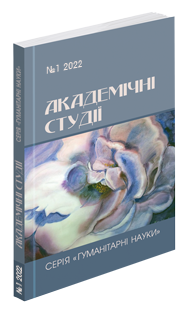Abstract
The report deals the sources, features of creation, expression of the content of images-symbols in various verbal and artistic structures of Ukrainian folk dumas. Based on the genre features of the dumas, emphasis is placed on the content of the artistic image, which are as a kind of explanation of the idea that is a symbol, and the image – a symbol of the idea. On The material of the heroic series of dumas «Kozak Golota», «Ivan Konovchenko» and «Sirchykha and Sirchenko» clarifies the content of the artistic symbol, which expresses the idea of resistance to the struggle of Ukrainians for their freedom and independence. The most expressive in the artistic and figurative system of folk dumas are the images of the Steppe, Way, House, which deepen the ideological and artistic content and reflect a number of motives, artistic and aesthetic content of Ukrainian folk dumas. The article emphasizes that the images of the Steppe and the Way in the duma epoch are expanded by the semantic triad Savur- grave – Valley – Steppe (field), which is a symbolic genetic code of the nation which combines past, present and future existence. The Steppe in dumas is a symbol of the struggle for one’s own independent self-being. It is noted that the boundless expanses of the Steppe gave rise in the Ukrainian psyche to freedom of life, social equality, reluctance to get rich. In the article we consider the symbolic image of the House (room) not as a symbol of family well-being and wealth, but as a sacred ideal space. In this space the idea of struggle for the native land from generation to generation is brought up, affirmed, transferred. The House is an archetype of rooting and non-eradication of the military spirit in the family. It is the Family (Rid) in dumas is the basis of the images of the Steppe, the Way, the House. In particular, it was emphasized that the House in the duma is a symbolic image of expression of the life-giving space in which future warriors are brought up on Cossack customs and traditions. Therefore, the House and the room in the Ukrainian folk duma are psychological synonyms in the expression of the peculiarities of the national worldview, world affirmation and world expression.
References
Братко-Кутинський О. Феномен України. К. : Вечірній Київ, 1996. 301 с.
Войтович В. Українська міфологія. Енциклопедія народних вірувань. К. : ФОП Стебеляк, 2014. 692 с.
Гарасим Я. Національна самобутність естетики українського пісенного фольклору. Львів : НВФ «Українські технології», 2010. 375 с.
Кононенко В. (1991). Словесні символи в семантичній структурі фраземи. Мовознавство. 1996. № 6. С. 30–36.
Костомаров Н. Историческое значение южнорусского народного песенного творчества. Словянская мифология. М. : Чарли, 1994. 688 с.
Набок М. Українські народні думи: національні особливості сприйняття в процесі міжкультурного спілкування. Психолінгвістика. 2018. 24(2). С. 198–217. DOI: https://doi.org/10.31470/2309-1797-2018-24-2-198-217
Nabok M. Teaching Ukrainian folk dumas at University: analysis in context of intercultural communication. Advanced Education. 2020. № 16. Р. 4–8. DOI: 10.20535/2410-8286.184554
Потебня А. О некоторых символах в славянской народной поэзии. Харьков : Университетская типография, 1860. 155 с.
Потебня А. О связи некоторых представлений в языке. Воронеж : Типография В. Гольдштейна, 1864. 119 с.
Українські народні думи. Том другий корпусу. Тексти №№ 14–33 і вступ Катерини Грушевської. Харків ; Київ : Пролетар, 1931. 304 с.
Формування національних основоположний підстав сучасного народознавства та літературознавства / упоряд. О. Вертій, О. Новікова. Випуск 1. К. : Українська літературна газета, 2018. 384 с.
Язичницькі настанови воїнові-козакові. URL: https://spadok.org.ua/ukrayinske-kozatstvo/yazychnytskinastanovy- voyinu-ozaku
Янковська Ж., Рарицький О., Марчук О. Відображення архетипного образу землі у новелах Василя Ткачука (за збіркою «Сині чічки»). Slavica Slovaca. 2020. № 55(2). С. 296–306.
Янів В. Нариси до історії української етнопсихології. Мюнхен : Український Вільний Університет, 1993. 93 с.

